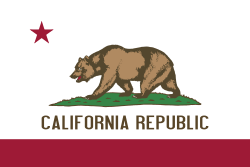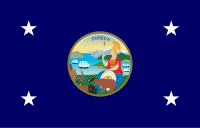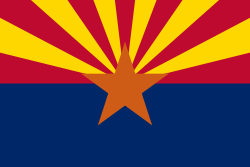John C. Frémont
| John Charles Frémont | |
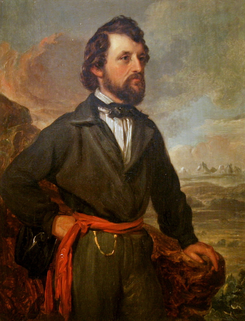 John C. Frémont, 1852 portrait, by William S. Jewett |
|
|
3rd Military Governor of California
|
|
| In office January 1847 – March 1, 1847[1] |
|
| Preceded by | Robert F. Stockton |
|---|---|
| Succeeded by | Stephen W. Kearny |
|
|
|
| In office September 9, 1850 – March 3, 1851 |
|
| Succeeded by | John B. Weller |
|
|
|
| In office 1878–1881 |
|
| Preceded by | John Philo Hoyt |
| Succeeded by | Frederick Augustus Tritle |
|
|
|
| Born | January 21, 1813 Savannah, Georgia, U.S. |
| Died | July 13, 1890 (aged 77) New York City, New York, U.S. |
| Political party | Democrat, Republican |
| Spouse(s) | Jessie Benton Frémont |
| Alma mater | College of Charleston |
| Profession | Politician |
| Religion | Episcopalian |
| Signature | |
| Military service | |
| Service/branch | United States Army |
| Years of service | 1838–1848 1861–1864 |
| Rank | Major General |
John Charles Frémont (January 21, 1813 – July 13, 1890), was an American military officer, explorer, the first candidate of the Republican Party for the office of president of the U.S., and the first presidential candidate of a major party to run on a platform opposing slavery. During the 1840s, that era's penny press accorded Frémont the sobriquet The Pathfinder. It remains in use, and he is sometimes called The Great Pathfinder.[2][3] During the American Civil War he was given command of the armies in the west but made hasty decisions (such as trying to abolish slavery without consulting Washington), and was relieved. He retired to California, where he was bogged down with lawsuits over land claims.
Historians portray Frémont as controversial, impetuous, and contradictory. Some scholars regard him as a military hero of significant accomplishment, while others view him as a failure who repeatedly defeated his own best purposes. Historian Andrew Rolle argues the keys to Frémont's character and personality may lie in his illegitimate birth, ambitious drive for success, self-justification, and passive-aggressive behavior.[4][5]
Parents
Frémont's mother, Anne Beverley Whiting, was the youngest daughter of socially prominent Virginia planter Col. Thomas Whiting. The colonel died when Anne was less than a year old. Her mother married Samuel Cary, who soon exhausted most of the Whiting estate. At age 17 Anne married Major John Pryor, a wealthy Richmond resident in his early 60s. In 1810 Pryor hired Charles Fremon, a French immigrant who had fought with the Royalists during the French Revolution, to tutor his wife. In July 1811 Pryor learned that Whiting and Fremon were having an affair. Confronted by Pryor, the couple left Richmond together on July 10, 1811, creating a scandal that shook city society.[6] Pryor published a divorce petition in the Virginia Patriot, in which he charged that his wife had "for some time past indulged in criminal intercourse". Whiting and Fremon moved first to Norfolk and later settled in Savannah, Georgia. Having recently inherited slaves valued at $1,900, Whiting financed the trip and purchase of a house in Savannah by their sale. When the Virginia House of Delegates refused Pryor’s divorce petition, it was impossible for the couple to marry. In Savannah Whiting took in boarders while Fremon taught French and dancing. On January 21, 1813, their first child, John Charles Fremon, was born.[7] Their son was illegitimate, a social handicap which he overcame later with his marriage to the daughter of a powerful U.S. senator.
While H. W. Brands, in Andrew Jackson, His Life and Times, claims Frémont added the accented "e" and the "t" to his name later in life,[8] Andre Rolle, in John Charles Frémont: Character as Destiny, states that John's father, originally named Louis-René Frémont, had changed his name to Charles Fremon or Frémon upon emigrating to Virginia. Thus, John was reclaiming his father's (and family's) true French name.[9]
Marriage
In 1841 John C. Frémont married Jessie Benton, daughter of Sen. Thomas Hart Benton from Missouri.[10] Benton, Democratic Party leader for more than 30 years in the Senate, championed the expansionist movement, a political cause that became known as Manifest Destiny. The expansionists believed that the North American continent, from one end to the other, north and south, east and west, should belong to the citizens of the U.S. They believed it was the nation's destiny to control the continent. This movement became a crusade for politicians such as Benton and his new son-in-law. Benton pushed appropriations through Congress for national surveys of the Oregon Trail (1842), the Oregon Territory (1844), the Great Basin, and Sierra Mountains to California (1845). Through his power and influence, Benton obtained for Frémont the position of leading each expedition.
Early expeditions
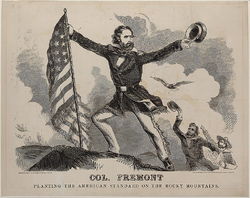
After attending the College of Charleston from 1829 to 1831,[11] Frémont was appointed a teacher of mathematics aboard the sloop USS Natchez. In July 1838 he was appointed a second lieutenant in the Corps of Topographical Engineers and assisted and led multiple surveying expeditions through the western territory of the United States and beyond. In 1838 and 1839 he assisted Joseph Nicollet in exploring the lands between the Mississippi and Missouri rivers. In 1841 with training from Nicollet, Frémont mapped portions of the Des Moines River.
Frémont first met frontiersman Kit Carson on a Missouri River steamboat in St. Louis during the summer of 1842. Frémont was preparing to lead his first expedition and was looking for a guide to take him to South Pass. Carson offered his services, as he had spent much time in the area. The five-month journey, made with 25 men, was a success.
From 1842 to 1846 Frémont and his guide Carson led expedition parties on the Oregon Trail and into the Sierra Nevada. During his expeditions in the Sierra Nevada, Frémont became the first American to see Lake Tahoe. He is also credited with determining the Great Basin as endorheic, that is, having no outlet to the sea or a river. One of Frémont's reports from an expedition inspired the Mormons to consider Utah for settlement.[10] He also mapped volcanoes such as Mount St. Helens.
Congress published Frémont's "Report and Map"; it guided thousands of overland immigrants to Oregon and California from 1845 to 1849. In 1849 Joseph Ware published his Emigrants' Guide to California, which was largely drawn from Frémont's report, and was to guide the forty-niners through the California Gold Rush. Frémont's report was more than a travelers' guide – it was a government publication that achieved the expansionist objectives of a nation and provided scientific and economic information concerning the potential of the trans-Mississippi West for pioneer settlement[12].
Third expedition
On June 1, 1845, John Frémont and 55 men left St. Louis, with Carson as guide, on the third expedition. The stated goal was to "map the source of the Arkansas River," on the east side of the Rocky Mountains. But upon reaching the Arkansas, Frémont suddenly made a hasty trail straight to California, without explanation. Arriving in the Sacramento Valley in early 1846, he promptly sought to stir up patriotic enthusiasm among the American settlers there. He promised that if war with Mexico started, his military force would "be there to protect them." Frémont nearly provoked a battle with Gen. José Castro near Monterey, camped at the summit of what is now named Fremont Peak. A conflict would likely have resulted in the annihilation of Frémont's group, due to the superior numbers of the Mexican troops. Frémont then fled Mexican-controlled California, and went north to Oregon, making camp at Klamath Lake.[13]
After an May 9, 1846, Indian attack on his expedition party, Frémont retaliated by attacking a Klamath Indian fishing village named Dokdokwas the following day, although the people living there may not have been involved in the first action. The village was at the junction of the Williamson River and Klamath Lake. On May 10, 1846, the Frémont group completely destroyed it. Afterward, Carson was nearly killed by a Klamath warrior. As Carson's gun misfired, the warrior drew to fire a poison arrow; but Frémont, seeing Carson's predicament, trampled the warrior with his horse. Carson felt he owed Frémont his life.[14]
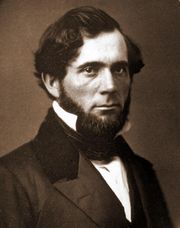
Mexican-American War
In 1846 Frémont was appointed lieutenant colonel of the California Battalion, also called U.S. Mounted Rifles and other names, which he had helped form with his survey crew and volunteers from the Bear Flag Republic. In late 1846 Frémont, acting under orders from Commodore Robert F. Stockton, led a military expedition of 300 men to capture Santa Barbara, California, during the Mexican-American War. Frémont led his unit over the Santa Ynez Mountains at San Marcos Pass in a rainstorm on the night of December 24, 1846. In spite of losing many of his horses, mules and cannon, which slid down the muddy slopes during the rainy night, his men regrouped in the foothills the next morning, and captured the presidio without bloodshed, thereby capturing the town. A few days later Frémont led his men southeast toward Los Angeles, accepting the surrender of the leader Andres Pico and signing the Treaty of Cahuenga on January 13, 1847, which terminated the war in upper California.[15]
On January 16, 1847, Commodore Stockton appointed Frémont military governor of California following the Treaty of Cahuenga. But U.S. Army Brig. Gen. Stephen Watts Kearny, who outranked Frémont (and who arguably had the same rank as Stockton, one star), said he had orders from the U.S. president and secretary of war to serve as governor. He asked Frémont to give up the governorship, which the latter stubbornly refused to do for a time. Kearny gave Frémont several opportunities to change his position. When they arrived at Fort Leavenworth in August 1847, Kearny arrested Frémont and brought him to Washington, for court martial. Fremont was convicted of mutiny, disobedience of a superior officer and military misconduct.
While approving the court's decision, Pres. James K. Polk quickly commuted his sentence of dishonorable discharge due to his services. Frémont resigned his commission and settled in California.[16] In 1847 he purchased the Rancho Las Mariposas land grant in the foothills of the Sierra Nevada mountains near Yosemite.
Fourth expedition
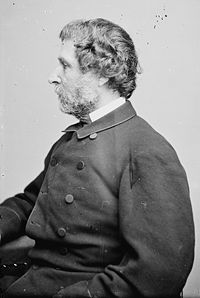
In 1848 Frémont and his father-in-law Sen. Benton developed a plan to advance their vision of Manifest Destiny, as well as restore Frémont's honor after his court martial. With a keen interest in the potential of railroads, Sen. Benton had sought support from the Senate for a railroad connecting St. Louis to San Francisco along the 38th parallel, the latitude which both cities approximately share. After Benton failed to secure federal funding, Frémont secured private funding. In October 1848 he embarked with 35 men up the Missouri, Kansas and Arkansas rivers to explore the terrain.
On his party's reaching Bent's Fort, he was strongly advised by most of the trappers against continuing the journey. Already a foot of snow was on the ground at Bent's Fort, and the winter in the mountains promised to be especially snowy. Part of Frémont's purpose was to demonstrate that a 38th parallel railroad would be practical year-round. At Bent's Fort he secured "Uncle Dick" Wootton as guide, and at what is now Pueblo, Colorado, he hired the eccentric "Old Bill" Williams and moved on.
Had Frémont continued up the Arkansas, he might have succeeded. On November 25 at what is now Florence, Colorado, he turned sharply south. By the time his party crossed the Sangre de Cristo Range via Mocha Pass, they had already experienced days of bitter cold, blinding snow and difficult travel. Some of the party, including the guide Wootton, had already turned back, concluding further travel would be impossible. Although the passes through the Sangre de Cristo had proven too steep for a railroad, Frémont pressed on. From this point the party might still have succeeded had they gone up the Rio Grande to its source, or gone by a more northerly route, but the route they took brought them to the very top of Mesa Mountain.[17] By December 12, on Boot Mountain it took ninety minutes to progress three hundred yards. Mules began dying and by 20 December only 59 animals remained alive. It was not until December 22 that Frémont acknowledged the party needed to regroup and be resupplied. They began to make their way to Taos, New Mexico. By the time the last surviving member of the expedition made it to Taos on February 12, 1849, 10 of the party were dead. But for the efforts of member Alexis Godey, another 15 would have been lost.[18] After recuperating in Taos, Frémont and only a few of the men left for California via an established southern trade route.
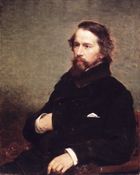
U.S. Senator and presidential candidate
Frémont was one of the first two senators from California, serving from 1850 to 1851.
Frémont was also the first presidential candidate of the new Republican Party in 1856. At the time of his campaign he lived in Staten Island, New York. The campaign was headquartered near his home in St. George.[19] He placed second to James Buchanan in a three-way election; he did not carry the state of California.
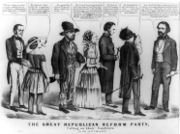
Civil War
Frémont later served as a major general in the American Civil War, including a controversial term as commander of the Army's Department of the West from May to November 1861. Frémont replaced William S. Harney, who had negotiated the Harney-Price Truce, which permitted Missouri to remain neutral in the conflict as long as it did not send men or supplies to either side.
Frémont ordered his Gen. Nathaniel Lyon to formally bring Missouri into the Union cause. Lyon had been named the temporary commander of the Department of the West, before Frémont ultimately replaced Lyon. Lyon, in a series of battles, evicted Gov. Claiborne Jackson and installed a pro-Union government. After Lyon was killed in the Battle of Wilson's Creek in August, Frémont imposed martial law in the state, confiscating secessionists' private property and emancipating slaves.
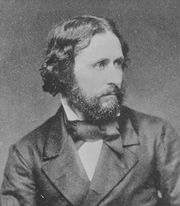
Pres. Abraham Lincoln, fearing the order would tip Missouri (and other slave states in Union control) to the southern cause, asked Frémont to revise the order. Frémont refused to do so, and sent his wife to plead the case. Lincoln responded by publicly revoking the proclamation and relieving Frémont of command on November 2, 1861, simultaneous to a War Department report detailing Frémont's iniquities as a major general. In March 1862 he was placed in command of the Mountain Department of Virginia, Tennessee and Kentucky.
Early in June 1862 Frémont pursued the Confederate Gen. Stonewall Jackson for eight days, finally engaging him at Battle of Cross Keys on June 8. Jackson slipped away after the battle, saving his army.
When the Army of Virginia was created June 26, to include Gen. Frémont's corps, with John Pope in command, Frémont declined to serve on the grounds that he was senior to Pope and for personal reasons. He then went to New York where he remained throughout the war, expecting a command, but none was given to him.[20]
Radical Republican presidential candidacy
In 1860 the Republicans nominated Abraham Lincoln for president, who won the presidency and then ran for reelection in 1864. The Radical Republicans, a group of hard-line abolitionists, were upset with Lincoln's positions on the issues of slavery and post-war reconciliation with the southern states. On May 31, 1864, they nominated Frémont for president. This frisson in the Republican Party divided the party into two factions: the anti-Lincoln Radical Republicans, who nominated Frémont, and the pro-Lincoln Republicans. Frémont abandoned his political campaign in September 1864, after he brokered a political deal in which Lincoln removed Postmaster General Montgomery Blair from office.
Later life
The state of Missouri took possession of the Pacific Railroad in February 1866, when the company defaulted in its interest payment. In June 1866 the state, at private sale, sold the road to Frémont. Frémont reorganized the assets of the Pacific Railroad as the Southwest Pacific Railroad in August 1866. In less than a year (June 1867), the railroad was repossessed by the state of Missouri after Frémont was unable to pay the second installment on his purchase.[21]
From 1878 to 1881 Frémont was governor of the Arizona Territory. Destitute, the family depended on the publication earnings of his wife Jessie.
Frémont lived on Staten Island in retirement. He died in New York City in 1890 of peritonitis, a forgotten man. He was buried in Rockland Cemetery, Sparkill, New York.[22][23]
Legacy
Plants
Frémont collected a number of plants on his expeditions, including the first recorded discovery of the Single-leaf Pinyon by a European American. The genus of the California Flannelbush (Fremontodendron californicum) is named for him, as are the species names of many other plants, including Frémont's chaff bush (Amphipappus fremontii), Western rosinweed (Calycadenia fremontii), pincushion flower (Chaenactis fremontii), goosefoot (Chenopodium fremontii), silk tassel (Garrya fremontii), moss gentian (Gentiana fremontii), vernal pool goldfields (Lasthenia fremontii), tidytips (Layia fremontii), desert pepperweed (Lepidium fremontii), desert boxthorn (Lycium fremontii), barberry (Mahonia fremontii), bush mallow (Malacothamnus fremontii), monkeyflower (Mimulus fremontii), phacelia (Phacelia fremontii), desert combleaf (Polyctenium fremontii), cottonwood tree (Populus fremontii), desert apricot (Prunus fremontii), indigo bush (Psorothamnus fremontii), mountain ragwort (Senecio fremontii), yellowray gold (Syntrichopappus fremontii), and chaparral death camas (Toxicoscordion fremontii).
Places
- Four U.S. states named counties in his honor: Colorado, Idaho, Iowa and Wyoming.
- Several states also named cities and towns after him, such as California, Michigan, Nebraska, New Hampshire, Ohio, and Utah.
- Likewise, Fremont Peak in the Wind River Mountains and Fremont Peak in San Benito County, California, are also named for the explorer.
- The Fremont River, a tributary of the Colorado River in southern Utah, was named after Frémont.
- Archaeologists named the prehistoric Fremont culture after the river, as the first archaeological sites of the culture were discovered near its course.
The City of Elizabeth, South Australia (now a part of the City of Playford) named a local park and high school Fremont in recognition of the sister city relationship it had with Fremont, California. The high school has since merged with Elizabeth High School, so the Pathfinder's legacy is carried by Fremont-Elizabeth City High School.
The "largest and most expensive 'trophy'" in college football is a replica of a cannon "that accompanied Captain John C. Frémont on his expedition through Oregon, Nevada and California in 1843–44". The annual game between the University of Nevada, Reno and the University of Nevada, Las Vegas is for possession of the Fremont Cannon.[25][26]
A barbershop chorus in Fremont, Nebraska, is named The Fremont Pathfinders.[27] The Fremont Pathfinders Artillery Battery[28] is an American Civil War reenactment group from the same community.
Fremont Street in Las Vegas, Nevada, is named in his honor, as are streets in Minneapolis, Minnesota, Kiel, Wisconsin, Manhattan, Kansas, Portland, Oregon, Grant City, Staten Island, New York, and Tucson, Arizona; the California cities of Fremont, Monterey, Seaside, Stockton, San Mateo, and San Francisco. Portland also has several other locations named after Frémont, such as Fremont Bridge. Other places named for him include John C. Fremont Senior High School in Los Angeles and Fremont Senior High School in Oakland, the John C. Fremont Branch Library located on Melrose Avenue in Los Angeles, and the John C. Fremont Branch Library in Tucson, Arizona. John C. Fremont Elementary School in Glendale, California bears his name, as do junior high or middle schools in Mesa, Arizona, Pomona, California, Roseburg, Oregon, and Oxnard, California. Fremont High School in Sunnyvale, California, is named for the explorer and its annual yearbook is called The Pathfinder. In addition, the Fremont Hospital in Yuba City, California,and the John C. Fremont Hospital, in Mariposa, California , (where Frémont and his wife lived and prospered during the Gold Rush) are named for him.
- The U.S. Army's (now inactive) 8th Infantry Division (Mechanized) is called the Pathfinder Division, after John Frémont. The gold arrow on the 8th ID crest is called the "Arrow of General Frémont."
- The 1983 historical novel Dream West by western writer David Nevin covers the life, loves and times of Frémont.
Genealogy
Frémont's great-grandfather, Henry Whiting, was a half-brother of Catherine Whiting. She married John Washington, uncle of George Washington.[29][30][31]
See also
- Frémont Emancipation
Notes
- ↑ Guinn, J. M. (1902). "XXXIV. Some Political History.". History of the State of California and Biographical Record of Santa Cruz, San Benito, Monterey, and San Luis Obispo Counties. Chapman. pp. 234–235. http://www.archive.org/stream/historyofstateof00guin/historyofstateof00guin_djvu.txt. Retrieved October 12, 2009. "The following is a list of the governors of California, Spanish, Mexican and American, with date of appointment or election:"
- ↑ Adams, Dennis. "The Man for Whom Fort Fremont was Named", Beaufort County (SC) Library, retrieved on February 1, 2007
- ↑ "John Charles Fremont", Sierra Nevada Virtual Museum, Biographies, retrieved on February 19, 2007
- ↑ Andrew Rolle, "Exploring an Explorer: California, Psychohistory, and John C. Fremont," Southern California Quarterly, March 1994, Vol. 76#1 pp 85–98
- ↑ Andrew F. Rolle, John Charles Fremont: Character As Destiny (1991)
- ↑ Nevins pp. 3–7. Chaffin pp. 19–21
- ↑ Chaffin, pp. 21–22
- ↑ Brands, H. W. (2005). Andrew Jackson, His Life and Times. Garden City: Doubleday. pp. 188–190. ISBN 0385507380.
- ↑ Rolle, Andrew (1991). John Charles Frémont: Character as Destiny. Norman: University of Oklahoma Press. pp. 2–5. ISBN 0585359547.
- ↑ 10.0 10.1
 "Frémont, John Charles". Appletons' Cyclopædia of American Biography. 1900.
"Frémont, John Charles". Appletons' Cyclopædia of American Biography. 1900. - ↑ John C. Fremont
- ↑ Stephen Craig Weiss, "The John C. Fremont '1842, 1843–'44 Report' and Map," Journal of Government Information, May 1999, Vol. 26#3 pp 297–313
- ↑ Chapter 11, "The Un-Alamo" pages 68 to 73, Sides, Blood and Thunder
- ↑ Chapter 16, "A Perfect Butchery" pages 86 to 88, Sides, Blood and Thunder
- ↑ Tompkins, Walker A. Santa Barbara, Past and Present. Santa Barbara, CA: Tecolote Books, 1975, pp. 33–35.
- ↑ Borneman, Walter R., Polk: The Man Who Transformed the Presidency and America. New York, NY,: Random House Books, 2008, pp. 284–85.
- ↑ Both Patricia Richmond in Trail to Disaster and David Roberts in A Newer World (New York: Simon & Schuster, 2000) detail the exact route.
- ↑ Roberts, David, A Newer World, page 241
- ↑ Republican National Political Conventions 1856–2008
- ↑ U.S. Civil War Generals – Union Generals – (Frémont); John Charles Fremont
- ↑ "100 Years of Service". 1960. http://thelibrary.springfield.missouri.org/lochist/frisco/history/100years.cfm. Retrieved 2006-04-20.
- ↑ "The Old Pathfinder Dead; Gen. John C. Fremont Expired at his Home Yesterday", New York Times, 14 July 1890
- ↑ "John Charles Fremont". Find A Grave. January 1, 2001. http://www.findagrave.com/cgi-bin/fg.cgi?page=gr&GRid=2615. Retrieved 2007-05-29.
- ↑ "Author Query". International Plant Names Index. http://www.ipni.org/ipni/authorsearchpage.do.
- ↑ [1]
- ↑ "Nevada Wolf Pack History". College Football History. http://www.collegefootballhistory.com/nv_wolfpack/history.htm. Retrieved 2007-09-19.
- ↑ The History of the Fremont Pathfinders. Barbershop Chorus. URL retrieved on February 19, 2007
- ↑ History of the Pathfinders Fremont Pathfinders Artillery Battery. URL retrieved on February 19, 2007
- ↑ Robert H. Wynn, "John Charles Fremont, Explorer!", 'Bob and Brenda Exploring' Newsletter, March 2006, Issue No. 16. URL retrieved on January 7, 2007.
- ↑ "The Diaries of George Washington", Vol. 2, 1976. The George Washington Papers, The Library of Congress. URL retrieved on January 7, 2007.
- ↑ Genealogical convolution, RootsWeb. URL retrieved on January 7, 2007.
References
- Sides, Hampton, Blood and Thunder: An Epic of the American West, Doubleday (2006), hardcover, 462 pages, ISBN-10: 0-385-50777-1 ISBN-13: 0-978-0-385-50777-6
Publications
- The Exploring Expedition to the Rocky Mountains in the Year 1842, and to Oregon and North California in the years 1843–'44. Washington: Gales and Seaton. 1845. http://books.google.com/books?id=W8ICAAAAMAAJ.
- The Exploring Expedition to the Rocky Mountains, Oregon and California, to Which is Added A Description of the Physical Geography of California. With Recent Notices of the Gold Region from the Latest and Most Authentic Sources. Buffalo: Derby Orton & Mulligan. 1853. http://books.google.com/books?id=rwY1AAAAIAAJ.
- The Life of Col. John Charles Fremont and His Narrative of Explorations and Adventures in Kansas, Nebraska, Oregon and California. New York and Auburn: Miller, Orton & Mulligan. 1856. http://books.google.com/books?id=eQMFAAAAYAAJ.
Further reading
- Brandon, William, The Men and the Mountain (1955) ISBN 0-8371-5873-7. An account of Frémont's failed fourth expedition.
- Chaffin, Tom, Pathfinder: John Charles Frémont and the Course of American Empire, New York: Hill and Wang, 2002 ISBN 0-8090-7557-1 ISBN 978-0-8090-7557-7
- Gano, Geneva M. "At the Frontier of Precision and Persuasion: The Convergence of Natural Philosophy and National Philosophy in John C. Fremont's '1842, 1843–44 Report and Map,'" ATQ ("The American Transcendental Quarterly"), Sept 2004, Vol. 18#3 pp 131–154
- Harvey, Miles, The Island of Lost Maps: A True Story of Cartographic Crime, Random House, 2000, ISBN 0-375-50151-7, ISBN 0-7679-0826-0.
- Herr, Pamela. Jessie Benton Frémont: American Woman of the 19th Century (1988), biography of his wife
- Miller, David. "Heroes' of American Empire: John C. Frémont, Kit Carson, and the Culture of Imperialism, 1842–1898," Dissertation Abstracts International, 2008, Vol. 68 Issue 10, p4447
- Nevins, Allan, Fremont: Pathmarker of the West, Volume 1: Fremont the Explorer; Volume 2: Fremont in the Civil War (1939, rev ed. 1955)
- Roberts, David (2001), A newer world: Kit Carson, John C. Fremont and the claiming of the American west, New York: Touchstone ISBN 0-684-83482-0
- Rolle, Andrew F. John Charles Fremont: Character As Destiny (1991), biography by leading scholar emphasizing psychology
- Tompkins, Walker A. Santa Barbara, Past and Present. Tecolote Books, Santa Barbara, CA, 1975.
Primary sources
- Harper's Weekly political cartoon, "That's What's the Trouble with John C."; Fremont's 1864 challenge to Lincoln's re-nomination. [2]
- David H. Miller and Mark J. Stegmaier, James F. Milligan: His Journal of Fremont's Fifth Expedition, 1853–1854; His Adventurous Life on Land and Sea, Arthur H. Clark Co., 1988. 300 pp.
External links
- Mr. Lincoln and Freedom: John C. Frémont
- John C. Frémont at the Biographical Directory of the United States Congress Retrieved on 2009-05-01
- The Generals of the American Civil War – Pictures of John Charles Frémont
- Guide to the Frémont Family Papers at The Bancroft Library
- Memoirs of my life : including in the narrative five journeys of western explorations during the years 1842, 1843–4, 1845–6–7, 1848–9, 1853–4 by John c. Fremont
- Address of welcome to General John C. Fremont, governor of Arizona territory, upon the occasion of his reception by his associates of the Association Pioneers of the Territorial Days of California, at their headquarters, Sturtevant House, New York, on ... August 1, 1878
 "Frémont, John Charles". Appletons' Cyclopædia of American Biography. 1900.
"Frémont, John Charles". Appletons' Cyclopædia of American Biography. 1900.- Works by or about John C. Frémont in libraries (WorldCat catalog)
- Works by John C. Frémont at Project Gutenberg
- John C. Frémont at Find a Grave
| Political offices | ||
|---|---|---|
| Preceded by John Philo Hoyt |
Governor of Arizona Territory 1878–1881 |
Succeeded by Frederick Augustus Tritle |
| United States Senate | ||
| New title | Senator from California (Class 1) 1850–1851 Served alongside: William M. Gwin |
Succeeded by John B. Weller |
| Party political offices | ||
| New political party | Republican Party presidential candidate 1856 |
Succeeded by Abraham Lincoln |
|
||||||||||||||
|
||||||||||
|
|||||||||||||||||||||||||
|
||||||||||||
